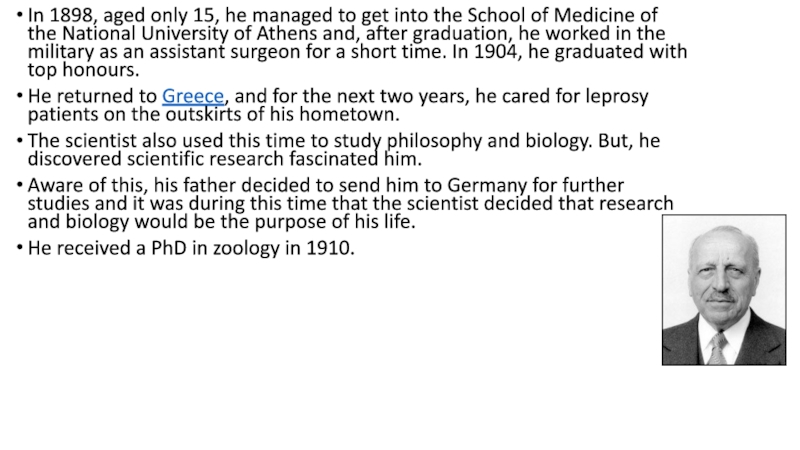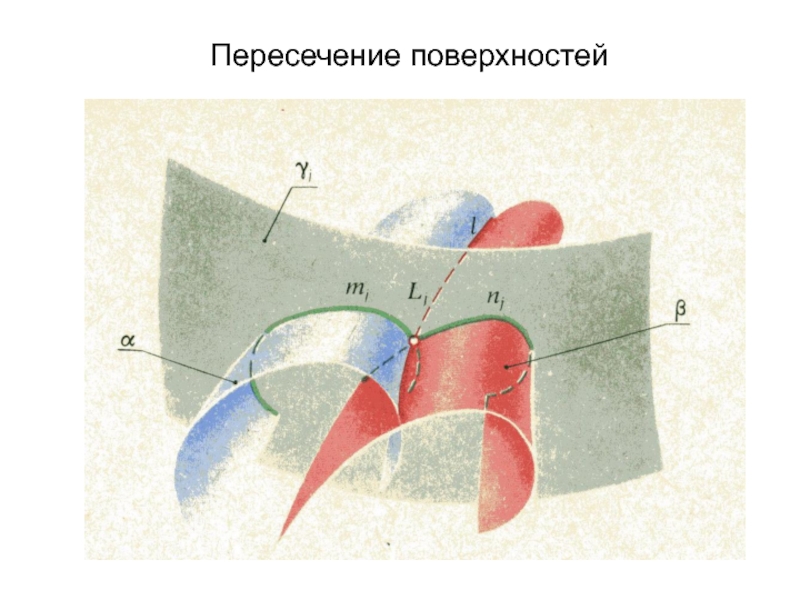Слайд 1Name:Youssef Abanoub
Group:19лс3а
Слайд 2Georgios Papanikolaou
Born on the Greek island of Euboea on May
13, 1883, Papanikolaou was one of four children.
He attended the
University of Athens, majoring in music and the humanities.
According to the tradition of those times, the firstborn son had to follow his father’s steps, but as his brother chose law, Papanikolaou, who was already showing an inclination towards medicine, took up the responsibility instead
Слайд 3In 1898, aged only 15, he managed to get into
the School of Medicine of the National University of Athens
and, after graduation, he worked in the military as an assistant surgeon for a short time. In 1904, he graduated with top honours.
He returned to Greece, and for the next two years, he cared for leprosy patients on the outskirts of his hometown.
The scientist also used this time to study philosophy and biology. But, he discovered scientific research fascinated him.
Aware of this, his father decided to send him to Germany for further studies and it was during this time that the scientist decided that research and biology would be the purpose of his life.
He received a PhD in zoology in 1910.
Слайд 4In 1910, after his return to Greece, Papanikolaou married the educated and
open-minded Andromache Mavroyeni (Mary). She was the descendant of the
Mavrogenous family who made history fighting against the Ottomans in the Greek War of Independence.
In 1913, he and his wife disembarked in New York.
The couple initially struggled to make a living – Papanikolaou sold carpets and played the violin in restaurants as Mary sewed buttons for $5 a week, but he would overcome the difficulties quickly.
In October 1914, Papanikolaou was recruited as a researcher at Cornell University, where he would work for the next 47 years.
There, Papanikolaou worked alongside his wife who served as a technician and sometimes test subject.
Слайд 5While Papanikolaou’s research would eventually be on human physiology, he started
his studies with guinea pigs.
He devoted his time researching early
cancer diagnosis through recovery and identification of exfoliated cancer cells.
From 1920, Papanikolaou started to focus on the cytopathology, a branch of pathology that studies and diagnoses diseases on the cellular level, of the human reproductive system.
The first time Papanikolaou identified the cancerous cell in a sample from a woman with cervical cancer, he confessed it was one of the most important experiences of his career.
His first clinical trial proved the diagnostic value of cytological examination of smears. This work became the cornerstone of his method that would allow the timely diagnosis of cervical cancer.
His achievements were received with doubt by the US medical community. However, he was convinced and continued his research.
He demonstrated the normal and abnormal smears taken from the cervix could be viewed under the microscope and be correctly classified.
This procedure, now known as the Pap (Papanikolaou) smear or test, became the standard in screening for cervical cancer.

Слайд 6The scientist worked relentlessly on his experiments for many years.
He often put in a six-and-a-half week and a 14-hour
day at Cornell and at his home in Douglaston Queens.
Physicians and other scientists from all parts of the world went to him at his Cornell laboratory to become proficient in his test technique.
In 1961, despite the fact that he was 78 years old, he decided to leave New York and settle in Miami. He planned to undertake the management of the Miami Cancer Institute.
However, he did not have the chance to inaugurate the institute himself. He died suddenly of a heart attack on February 19, 1962. The institute was renamed the Papanikolaou Cancer Research Institute in his honour.
Throughout his career, Papanikolaou kept bonds with Greece and maintained interest in the country’s politics.
Mary, his wife, continued his work in Miami until her death in 1982. “There was no other option for me but to follow him inside the lab, making his way of life mine,” she is quoted as saying.
Her devotion was such that, according to local publications, she decided not to have children in order to always be by him.

Слайд 7In 1978, Papanikolaou’s work was honoured by the US Postal
Service with a 13-cent stamp for early cancer detection.
Between 1995
and 2001, his portrait appeared on the Greek 10,000 drachma banknote, until its replacement by the euro.
He never received the Nobel Prize, but was nominated twice. He also received the Albert Lasker Award for clinical medical research in 1950.
The scientist’s bibliography consists of 158 articles and five scientific books.
One of the most important examples is the famous Atlas of Exfoliative Cytology. The book is considered by many a milestone in the science of cytology.
Слайд 8When he returned to Greece in 1910, Papanikolaou realized that
the conditions were not favorable to his plans for the
future. He married the educated and open-minded Andromachi – or Machi, as he called her – Mavrogenous (a descendant of the Mavrogenous family who made history fighting against the Ottomans in the Greek War Of Independence). Right after their marriage, he decided to leave Greece again. He clarified his position to his parents, explaining that his “ideal in life was neither to become rich, nor to live happily, but to work, act, create and do something worthy of a man who is moral and strong.”
The young married man’s first stop was at the Oceanographic Institute of Monaco. In 1911, he took part in a scientific expedition on Prince Albert’s oceanographic vessel L’Hirodelle. A year later, during the Balkan Wars (1912-1913), he was conscripted into the army as an Assistant Medical Reserve and returned to Greece. During this time, he met a number of compatriots who had previously migrated to America and were now back in Greece voluntarily, to fight. From conversations with them, he began to form the opinion that the New World was the place where the conditions for scientific research were at their best.

Слайд 9On October 19, 1913, Georgios Papanikolaou, together with his wife,
disembarked in New York. The couple initially faced serious financial
difficulties. At the beginning, they lived in a single room on 116th Street and both worked at Gimbels Department Store. He sold carpets and, in the evenings, played the violin in various restaurants, while she sewed buttons for five dollars a week.
However, although poor and seemingly unknown, Papanikolaou overcame the difficulties quickly. He found work as a journalist for the Greek paper Atlantis and was later recruited by the New York Hospital, having been recommended by Professor Thomas Hunt Morgan of Columbia University. Dr Morgan knew Papanikolaou from Germany and appreciated his work. Finally, in October 1914, he started working at Cornell University where he would remain for the next 47 years. Two months later, his wife Machi joined him as his technician.
Papanikolaou’s bibliography consists of 158 articles and five scientific books. The most prominent of them is the famous Atlas of Exfoliative Cytology. The book is a milestone not only in the science of cytology, but also in the medical bibliography of the 20th century as a whole.
Even though he never received a Nobel Prize (although he was nominated twice), he was awarded many medical prizes, both during his life and posthumously.

Слайд 10The 1920s were the most productive but also the most
difficult years of his efforts. The experimental stage of his
research began with vaginal smears from actual guinea pigs. The results were encouraging. Shortly afterwards, Papanikolaou began to experiment on vaginal smears from his own wife and, eventually, female patients at a hospital affiliated with Cornell.
When he identified cancerous cells in a sample from a woman with cervical cancer, he confessed that it was one of the most staggering experiences of his scientific career. The first clinical trials proved the diagnostic value of cytological examination of smears. This work became the cornerstone that established his method for the timely diagnosis of cervical cancer.
Слайд 11Thanks to his perseverance, Dr Pap’s pioneering cytodiagnostic method became both
accepted and internationally known under the medical abbreviation Pap test.
To this day, it is used worldwide for the diagnosis of cervical cancer, precancerous dysplasia and other cytological diseases of the female reproductive system. Throughout his career, the great researcher and scientist kept unbreakable bonds with Greece and maintained his interest in Greek politics and the various intellectual and social movements in the country. His wife continued his work in Miami until her death in 1982. She believed that one is born a scientist and that research comes to fruition only inside labs. For this reason, she said, “There was no other option for me but to follow him inside the lab, making his way of life mine.” She was so devoted to him that she decided not to have children in order to always be by him. She said that she never regretted it.































